Government mail service may be affected by the Canada Post labour disruption. Learn about how critical government mail will be handled.
Overview
Plants and animals that are not native to Alberta can become invasive if they are released into our waters. These species are known as aquatic invasive species and can harm our environment, economy and human health.
Aquatic invasive species legislation
Under the federal Aquatic Invasive Species Regulations, it is illegal to introduce an aquatic species into a body of water where it is not native, unless authorized under federal, provincial or territorial law.
The Fisheries (Alberta) Act regulates the purchase, possession and release of 52 prohibited species in Alberta.
Don’t let it loose
You can help prevent the introduction and spread of aquatic invasive species. Never release aquarium pets, water garden plants, live food (example: fish, crabs, mollusks) or live bait into rivers, streams, lakes, ponds or storm sewers. Sport fish may only be released back into the waters from which they were caught (example: catch-and-release) – never move a sport fish from one body of water to another.
Releasing any organism into a body of water is illegal and has the potential to start an invasion, but you can stop it. Stop the spread of aquatic invasive species – don’t let it loose.
Learn how to identify aquatic invasive species in Alberta.
Report aquatic invasive species
Report sightings of aquatic invasive species to the Aquatic Invasive Species Hotline:
Phone: 1-855-336-BOAT (2628)
Email: [email protected]
Connect with us on
Pets and plants from aquariums, ponds or water gardens
Many animals and plants sold for aquariums and water gardens are not native to Canada. Some owners think that releasing a pet that becomes too large, too difficult to care for or that they no longer want is the most compassionate thing to do. This is not true.
Domestic pets generally do not have the survival skills to live beyond their tank or pond. They can starve to death or may be eaten by predators in the wild. In some cases, they may survive, reproduce and spread, becoming invasive to the area they have been released in. Even if your pet is native to the local environment, it should never be released, as it may be carrying diseases or parasites.
Goldfish
Alberta currently has more than 50 populations of goldfish living throughout the province, which has shown that not only do goldfish have the survival skills, but they are able to thrive as far north as Fort McMurray. Other species, such as black bullhead and rosy-red minnows have also been found in ponds in Alberta.

Plants
Fish aren't the only problem! Small pieces or seeds from water garden plants can also thrive and cause an invasion if released. Invasive plants, such as flowering rush and pale yellow iris have been introduced in Alberta as well.

What you should do instead
Be a responsible pet and plant owner and care.
Live food
Some people intentionally release live food (example: fish, crabs, mollusks) from grocery stores or fish markets into the wild as an act of compassion or mercy. This can be harmful to both the released animal (which may not survive in the new environment) or to native species if it survives and becomes invasive. Northern Snakehead may have established its first invasive population in North America through a mercy release.
What you should do instead
- Ensure all of the food you purchase is dead before leaving the store.
- If you practice compassion or mercy release for religious or cultural reasons, explore alternative methods, such as volunteering with wildlife hospitals that release animals back into their natural environment.
- Always obtain authorization from your provincial or territorial Introductions and Transfers Committee before moving any plants or animals, including importing into Canada, transporting between provinces and territories, or transferring from one waterbody to another.

Bait
Bait is often used to catch larger fish in recreational fishing. Bait includes, but is not restricted to:
- bait fish
- earthworms
- fish eggs
- gammarus shrimp
- larvae, pupae or adults of aquatic insects (example: stonefly, mayfly, caddis fly)
- leeches
- maggots
- meal worms
- parts of fish
- terrestrial insects
- wax worms
No person shall angle using any fish as bait, other than dead bait, dead smelt, dead herring, dead shrimp, dead fish eggs or the skin, fins or eyes of game fish caught by angling.
Bait fish applies to any of the following:
- Iowa darter (Etheostoma exile)
- minnows (family Cyprinidae)
- sticklebacks (family Gasterosteidae)
- suckers (family Catostomidae)
- trout-perch (Percopsis omiscomaycus)
The exceptions are that no carp, goldfish or the western silvery minnow can be used as bait. Crayfish cannot be used for bait in Alberta.
Anglers that use dead bait should never dump it or the contents of a bait container into a waterbody other than where it was collected, as this can lead to the introduction of pathogens or diseases.
What you should do instead
- Always follow Alberta sportfishing regulations regarding bait use.
- Use artificial bait as a safer alternative when fishing. Remember, dead or frozen bait can carry diseases.
- Never move live or dead bait from one waterbody to another – it is illegal.
- Dispose of unused bait, dead fish, fish parts and water or debris from bait buckets in a secure waste disposal area. It is unlawful to dispose of unused bait within 50 metres of waterbodies except in regularly serviced waste disposal receptacles.

Sport fish
Deliberately releasing sport fish without authorization in new waterbodies to create angling opportunities is illegal. Sport fish are often large, predatory or generalist feeders. This means they can have widespread negative impacts on a variety of native species. Even species that are native in some parts of Canada or Alberta can become invasive beyond their natural range.
Some non-native fish that have been illegally moved within Alberta for recreational fishing purposes and have caused significant damage include:
- northern pike
- yellow perch
For more information, see Invasive fish species.
What you should do instead
- Never transfer sport fish from one waterbody to another.
- Always obtain authorization from your provincial or territorial Introductions and Transfers Committee before moving any plants and animals, including importing into Canada, transporting between provinces and territories or moving from one waterbody to another.
Report sightings of aquatic invasive species to the Aquatic Invasive Species Hotline.

Resources
Series of resources to support the Don't Let It Loose campaign to educate Albertans on the unwanted effects of releasing aquatic invasive species into Alberta waters.
Posters
-
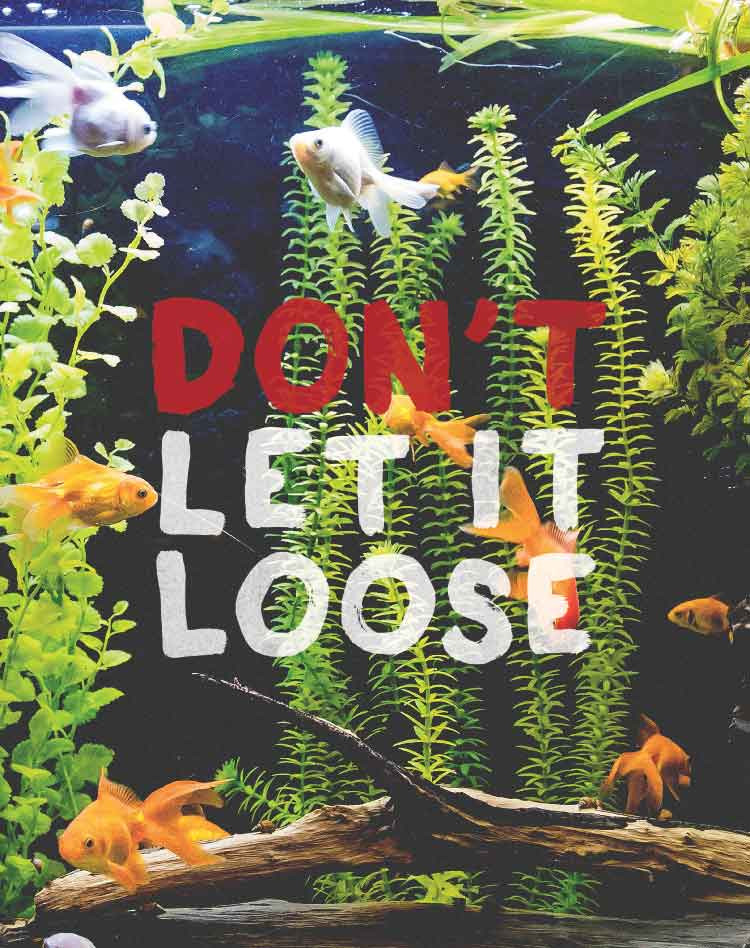 Aquarium and pond plants and animals
Aquarium and pond plants and animalsNever release aquarium or domestic pond water, plants, dead or live animals into waterbodies. Common aquarium and pond plants and animals can become invasive when released in the wild, potentially causing both ecologic and economic harm.
-
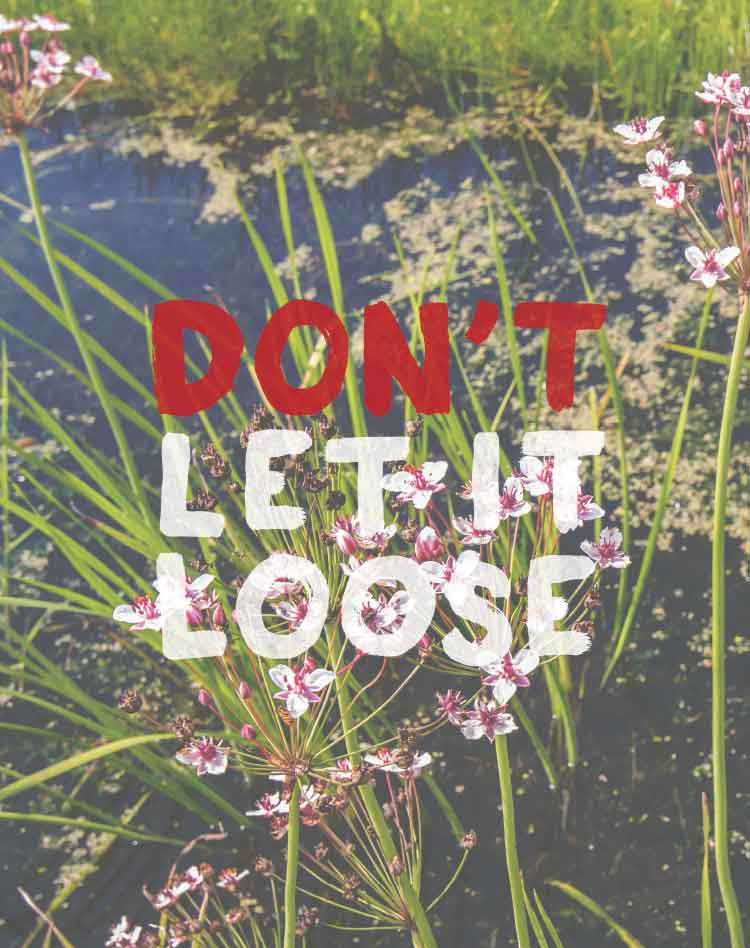 Aquaculture plants
Aquaculture plantsCommon aquaculture plants can become invasive if they are not native to Alberta. Wind can spread seeds beyond your garden which creates new populations that can dominate ecosystems, therefore ruining habitat for native species.
-
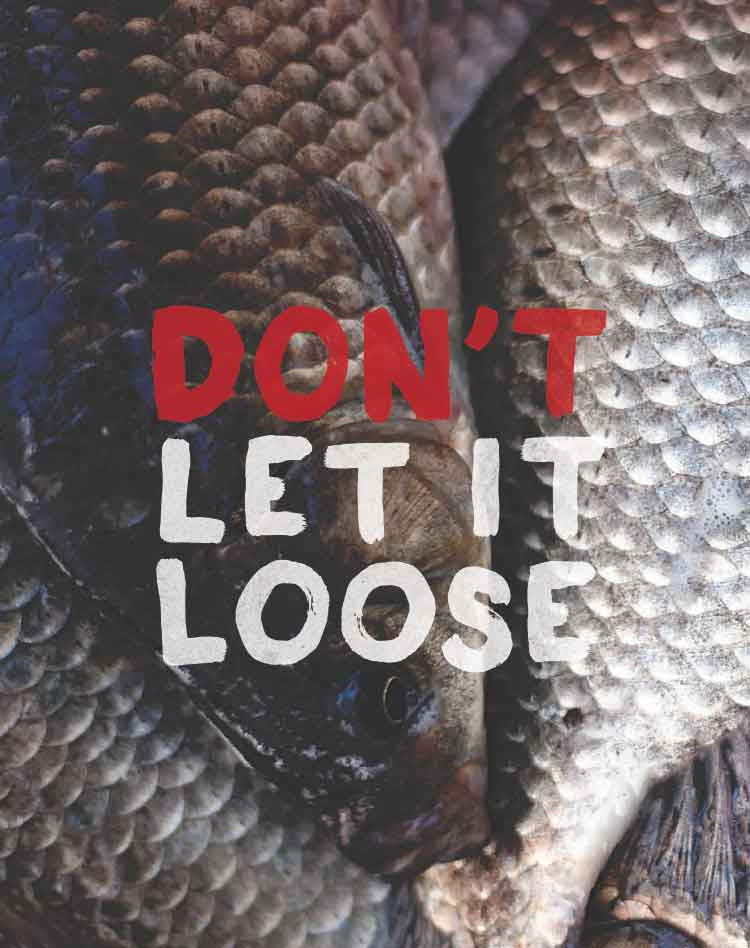 Live food
Live foodIt is illegal to release fish into waterbodies! Species that are not native to Alberta can become invasive when released in the wild, increasing competition for resources and spreading diseases to native species.
Information sheets for alerts on different species
-
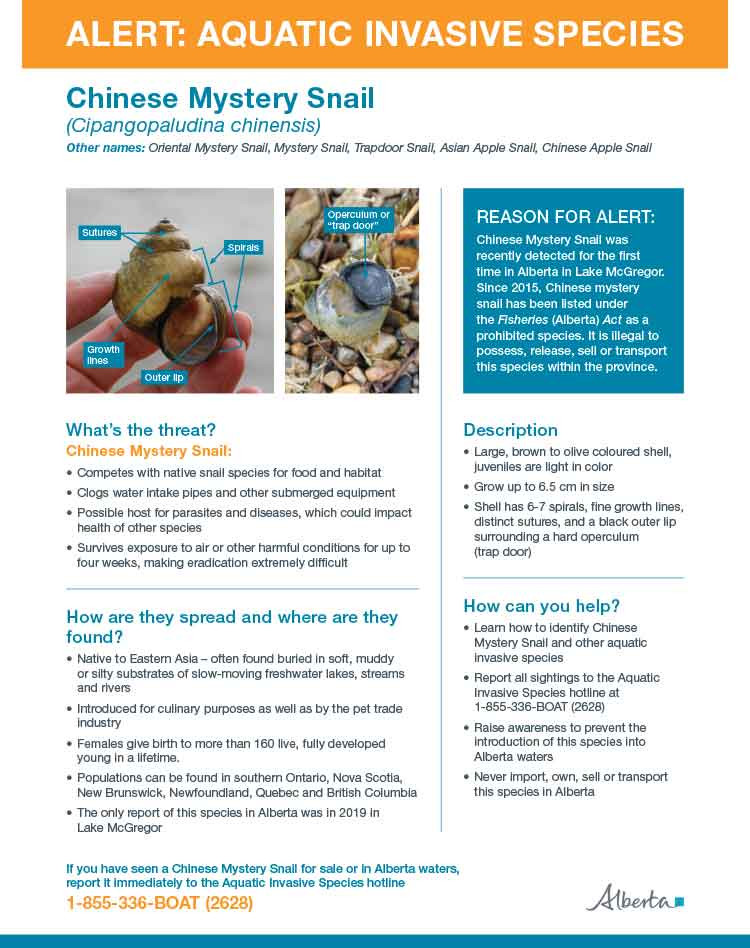 Chinese Mystery Snail alert
Chinese Mystery Snail alertInformation on the Chinese mystery snail, which was found for the first time in Alberta in Lake McGregor, in 2019.
The fact sheet includes a description of the snail, why it is listed as a threat, and how the snails are spread.
-
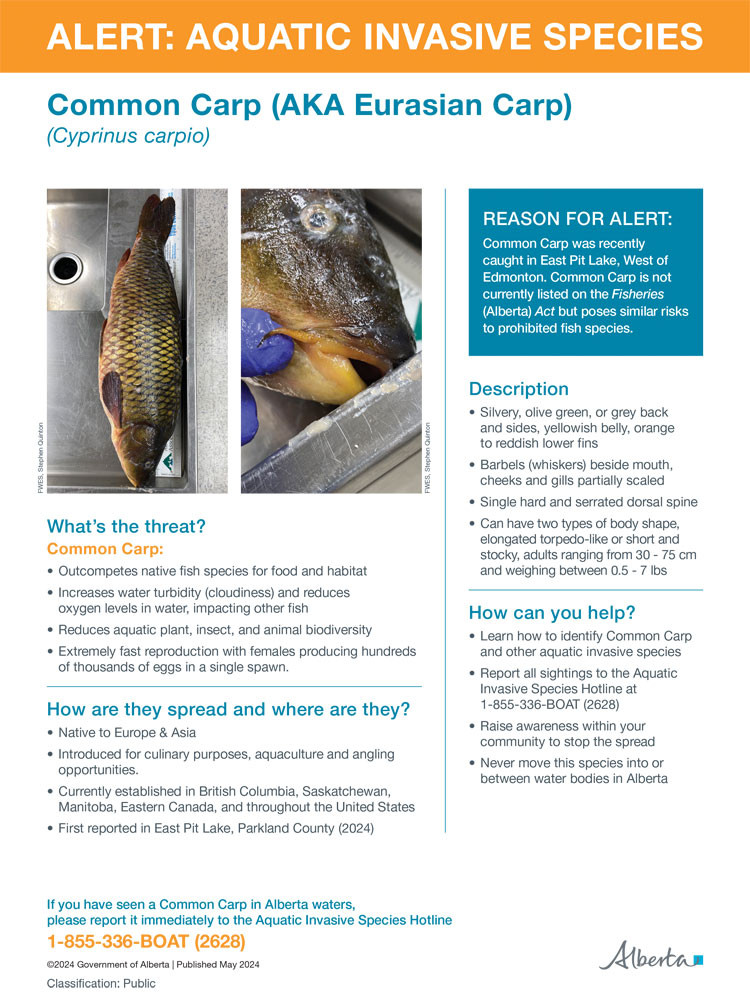 Common Carp alert
Common Carp alertInformation on the Common Carp, which was found for the first time in Alberta in East Pit Lake, in 2024.
The fact sheet includes a description of the fish, their impacts on the environment and how you can help prevent the spread.
-
 Crappie
CrappieInformation on Crappies, which has been found in Cardiff Trout Pond, North of Edmonton. Crappies are not currently listed on the Fisheries (Alberta) Act, but possess similar risks to prohibited fish species.
The fact sheet includes a description of the fish, their impacts on the environment and how you can help prevent the spread.
-
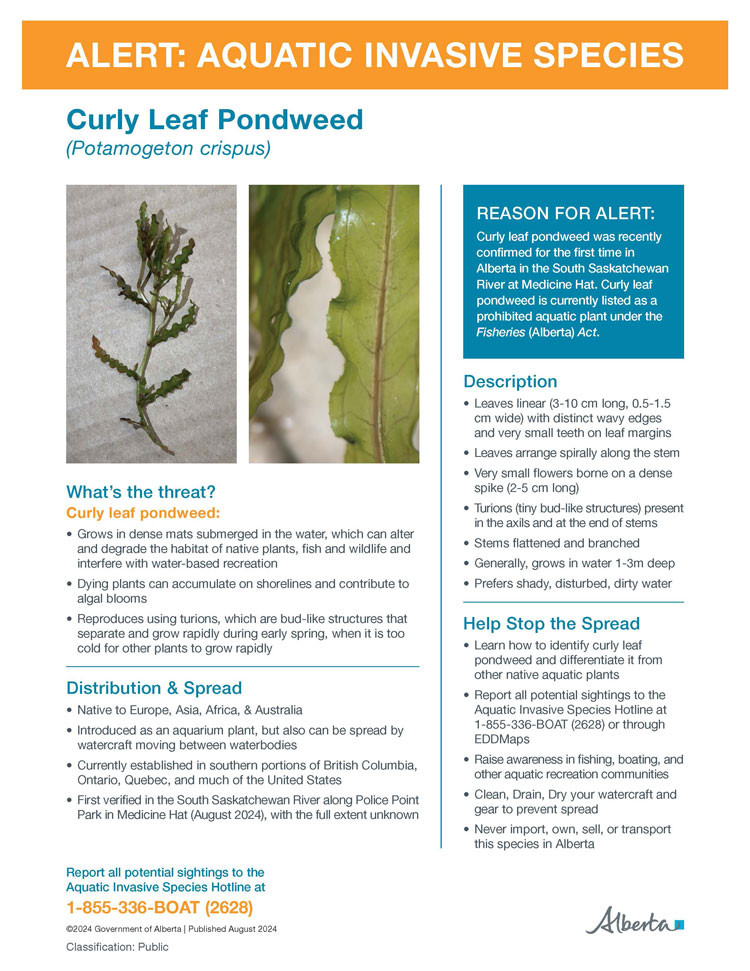 Curly Leaf Pondweed alert
Curly Leaf Pondweed alertInformation on curly leaf pondweed, which was confirmed for the first time in the South Saskatchewan River in Medicine Hat in 2024.
The fact sheet includes a description of the plant, its impact on the environment and how you can help prevent the spread.
-
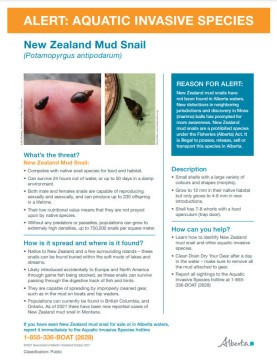 New Zealand Mud Snail alert
New Zealand Mud Snail alertInformation on New Zealand mud snails, where have been found in moss (marimo) balls being sold in Alberta, with populations expanding in British Columbia, Montana and Ontario.
The fact sheet includes a description of the snail, why it is a threat to Alberta and how the snails are spread.
-
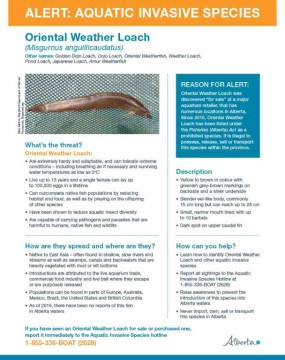 Oriental Weather Loach alert
Oriental Weather Loach alertSpecies was discovered 'for sale' at a major aquarium retailer, that has numerous locations in Alberta. Since 2015, Oriental Weather Loach has been listed under the Fisheries (Alberta) Act as a prohibited species. It is illegal to possess, release, sell or transport this species within the province.
-
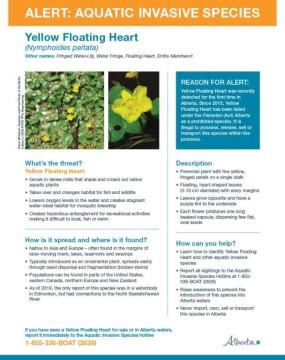 Yellow Floating Heart alert
Yellow Floating Heart alertSpecies was recently detected for the first time in Alberta. Since 2015, Yellow Floating Heart has been listed under the Fisheries (Act) Alberta as a prohibited species. It is illegal to possess, release, sell or transport this species within the province.
-
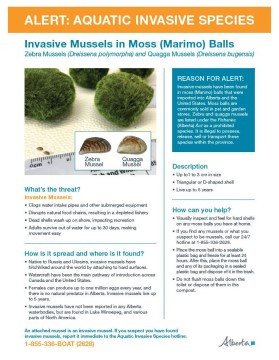 Zebra Mussels alert
Zebra Mussels alertSpecies was recently found in moss (marimo) balls imported into Canada and the United States and commonly sold at pet or garden retailers. Zebra and quagga mussels are listed under the Fisheries (Alberta) Act as a prohibited species. It is illegal to possess, release, sell or transport these species within the province.
- Zebra Mussels in Moss (Marimo) Balls alert
- For retailers: Decontamination protocol for invasive mussels in moss balls – Moss/Decorative Algae Ball Products Contain Zebra Mussels
Quick facts
-
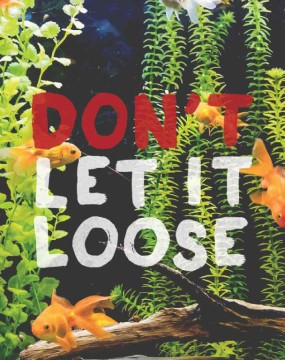 Quick Facts: Don't Let It Loose
Quick Facts: Don't Let It LooseNever release aquarium or domestic pond water, plants, dead or live animals into waterbodies. Common aquarium and pond plants and animals can become invasive when released in the wild, altering habitat, increasing competition for limited resources and spreading disease to native species.
-
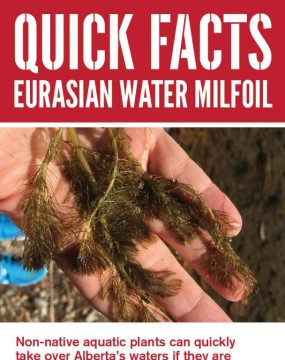 Quick Facts: Eurasian Water Milfoil
Quick Facts: Eurasian Water MilfoilEurasian water milfoil is an invasive plant species that is native to Eurasia and North Africa. It can form thick, dense mats that decrease oxygen levels, shade native plants and obstruct recreational activities, negatively impacting human activities and native fish and wildlife. Control of Eurasian water milfoil is very difficult once it's established – always clean, drain, dry your gear to prevent the spread!
Infographics
-
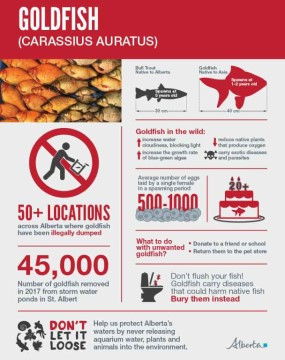 Goldfish infographic
Goldfish infographicFacts on the problems associated with releasing goldfish in Alberta waterbodies.
-
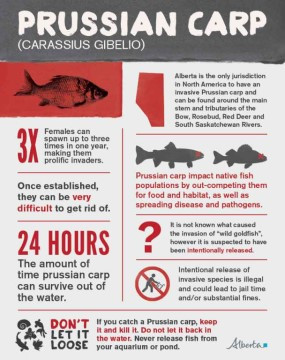 Prussian Carp infographic
Prussian Carp infographicFacts on the problems associated with Prussian carp in Alberta waterbodies.